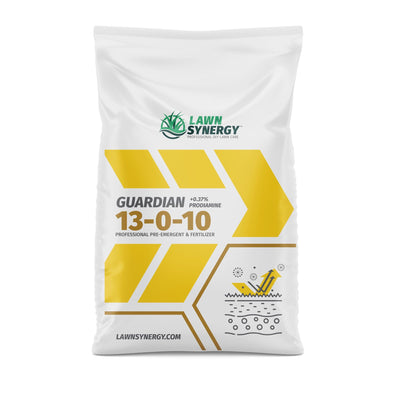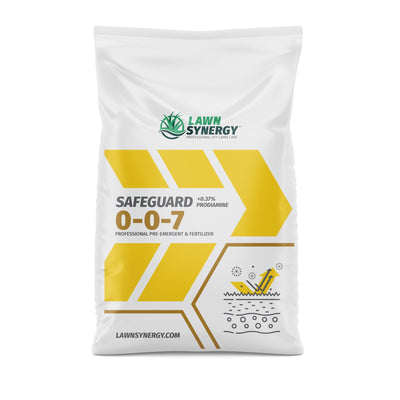Spraying pre-emergent can be one of the most powerful weed control moves you make all season. That is, if you get the timing, coverage, and product right.
Many homeowners rely on granular formulas without realizing that a liquid pre-emergent can offer more precision and faster soil activation. Done properly, spraying gives you pro-grade results while staying in total control of your lawn plan.
At Lawn Synergy, we've helped thousands of DIYers lock out weeds before they start. This guide breaks down everything you need to know — no fluff, just clear answers backed by decades of estate-level lawn care.
What this article covers:
- Why Choose a Sprayable Pre-Emergent
- Spray vs. Granular: Which Is Better for Your Lawn?
- When to Spray Pre-Emergent for Best Results
- Step-by-Step Guide to Spraying Pre-Emergent
- Common Mistakes to Avoid When Spraying
Why Choose a Sprayable Pre-Emergent
Liquid pre-emergent herbicides are gaining popularity with DIYers, and for good reason.
Spray applications provide:
- Even coverage across turf, including tight spots and irregular edges
- Faster soil absorption, making them ideal when rain or irrigation is unpredictable
- Flexible rates and precision, especially for spot-treating problem zones
Most professional lawn care crews rely on sprayables for these very reasons. Products like prodiamine or dithiopyr in liquid form give you control over application rate and water volume, especially important on sloped areas or dense turf.
Spraying pre-emergent is particularly useful when applying a barrier just before unexpected rain or when you need to fine-tune coverage around walkways, garden beds, or newly seeded areas (just be careful — more on that later).

Spray vs. Granular: Which Is Better for Your Lawn?
The liquid vs granular pre-emergent debate continues. However, choosing between spray and granular pre-emergents isn't just a matter of preference. It's about what works best for your lawn's shape, soil type, and maintenance goals.
Both application types are effective when used properly, but they serve different needs depending on how precise you want to be.
Sprayable options provide professional-level targeting, particularly in high-risk areas. Granulars, on the other hand, are more forgiving for beginners and provide solid, all-over coverage, especially on wide, uniform spaces. Here's how the two compare.
Granular Pre-Emergent
Many homeowners favor granular pre-emergents because they're familiar, straightforward, and easy to apply using a broadcast or drop spreader. They're especially effective on large, flat lawns where you can walk clean passes and get even distribution.
- Easier for beginners: Minimal equipment needed and low risk of overapplying
- Requires irrigation: Needs about 0.5 inch of water after application to activate properly
- Less precision: Can be hard to control around edges, garden beds, or curved borders
- Great for large, open areas: Covers space quickly with minimal prep work
At Lawn Synergy, our Safeguard 0-0-7 Pre-Emergent Lawn Fertilizer is a top pick for homeowners who want a low-hassle, nutrient-enhanced solution that blocks weed germination while feeding their turf.

Sprayable Pre-Emergent
Spray applications are the go-to for lawn care professionals and for good reason. They allow for tighter control, faster activation, and customized treatment in irregular areas or zones where weeds tend to break through every season.
- High precision: Ideal for curved edges, small patches, slopes, and tight corners
- Quick soil absorption: Activates faster, especially in dry conditions where granulars may sit dormant
- Calibration required: You'll need to dial in your sprayer to apply the right volume per 1,000 sq ft
- Better for experienced DIYers or for homeowners who want to step up their application game
Spraying pre-emergent also provides flexibility in mixing, allowing you to tank-mix compatible fertilizers or post-emergents if needed. However, always follow label directions carefully to avoid chemical interactions.
For example, if you're targeting recurring crabgrass hotspots near walkways or fence lines, spraying lets you get the coverage exactly where you need it, without wasting product on the rest of the lawn.
When to Spray Pre-Emergent for Best Results
Timing is everything. Spray too early, and the product breaks down before seeds germinate. Spray too late, and the weeds are already growing.
The key indicator isn't the calendar but rather the soil temperature. You want to spray just before soil temps hit 55°F, which is when most spring annuals (like crabgrass) start to germinate. In fall, aim for 70°F to block cool-season invaders like annual bluegrass.
Here's a basic seasonal breakdown:
- Spring (late Feb to early April in warmer zones)
- Fall (late August through October)
Use a soil thermometer or a zip code-based soil tracker to time it right. The moment your soil hits the target range, it's go time. Spraying pre-emergent means faster activation than granular, allowing you to target narrow windows of opportunity.

Step-by-Step Guide to Spraying Pre-Emergent
You don't need commercial equipment or a landscaping license to spray pre-emergent effectively. With the right product, calibrated gear, and attention to detail, DIY homeowners can match professional results.
Choose the Right Product
Start with a pre-emergent that uses a proven active ingredient like prodiamine or dithiopyr. These provide a long residual effect in the soil, creating a stable barrier that prevents weed seeds from taking hold.
Check the label to ensure it's appropriate for your grass type and region. Many Lawn Synergy customers choose Guardian 13-0-10 for pre-emergent coverage with built-in nutrients.
Calibrate Your Sprayer
Whether you use a backpack sprayer, pump sprayer, or hose-end model, you need to know how much solution you're applying per 1,000 square feet.
Most products call for 0.5 to 1 ounce of concentrate per 1,000 sq ft, but this varies. Perform a test spray over a measured area to dial in the exact output before treating your entire lawn.
Calibration ensures you avoid underdosing (which weakens control) or overdosing (which can harm turf).

Spray Evenly and Consistently
Walk in straight, overlapping passes to ensure full coverage. Aim for a 25 to 50% overlap on each pass to avoid streaking or missed zones.
Keep a steady pace and consistent nozzle pressure. Avoid overapplying near sidewalks, driveways, or flower beds — excess chemical can runoff and damage non-target plants or cause staining.
Water It In, If Required
Some sprayable pre-emergents require post-application watering to help the product move into the soil where it can form a barrier.
Unless your label says otherwise, apply 0.25 to 0.5 inches of water using irrigation or rainfall shortly after spraying. If your product is “rainfast,” it will bind quickly on its own. When in doubt, light watering is better than none.
Avoid Foot Traffic
Once applied, the treatment needs time to bind to the soil surface. Avoid walking or mowing for at least 24 hours to keep the barrier intact and undisturbed.
Compaction or abrasion can reduce effectiveness in high-traffic areas, so give it time to settle.
This same method applies if you're wondering, can I apply pre-emergent and post-emergent at the same time? In some cases, yes. But make sure products are compatible and follow label instructions for tank mixing or spacing.

Common Mistakes to Avoid When Spraying
Even seasoned lawn enthusiasts can miss the mark. Watch out for these pitfalls:
- Spraying too early or too late: If weeds are already up, the product won't stop them. You'll need a post-emergent instead.
- Skipping the water-in step: Without water, pre-emergent just sits on top of the soil and breaks down. No barrier, no results.
- Overlapping seeding and pre-emergent: Planning to seed with Crown Jewel Elite Tall Fescue? Avoid spraying beforehand. Pre-emergent blocks all seed germination, including grass seed.
- Incorrect sprayer calibration: Using too much or too little product compromises effectiveness. Always test your output before treating the whole lawn.
- Not following up: Some stubborn weeds may need a second application in 6–8 weeks. Check label reapplication intervals and plan ahead.
Conclusion
Spraying pre-emergent is a strategic, pro-level move that gives you more control over weed prevention, especially when timing, product choice, and technique align.
While it requires more attention than tossing down granules, the reward is clear: cleaner turf, fewer weeds, and a lawn that looks professionally managed without the contractor price tag.
At Lawn Synergy, we empower homeowners with pro-grade solutions like Guardian 13-0-10 Pre-Emergent Lawn Fertilizer, along with expert advice tailored to your lawn's region, season, and condition.
Need help with product selection or timing? Reach out. We'll build your plan together.
Ready to learn more about lawn care? Check out these articles:



